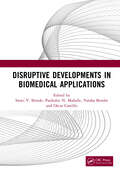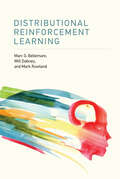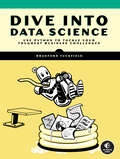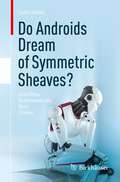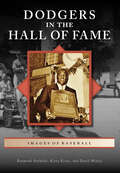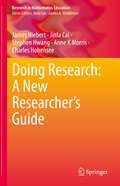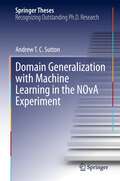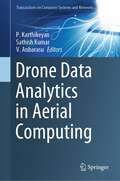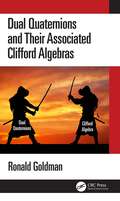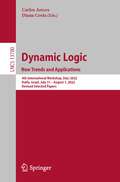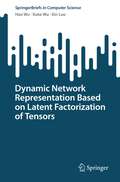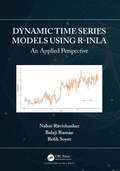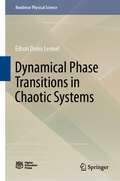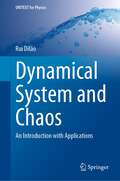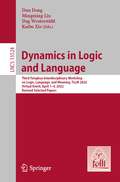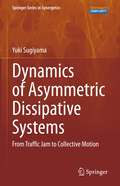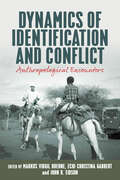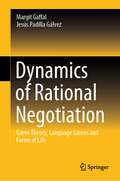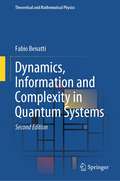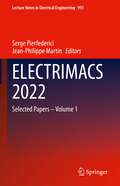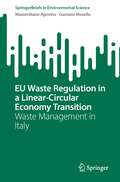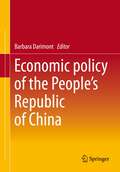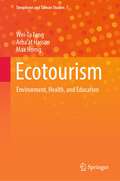- Table View
- List View
Disruptive Developments in Biomedical Applications
by Oscar Castillo Parikshit N. Mahalle Swati V. Shinde Varsha BendreThis book covers advancements and future challenges in biomedical application development using disruptive technologies like AI, IoT and signal processing. Book is divided into four main sections namely medical image processing using AI, IoT and biomedical devices, biomedical signal processing and electronic health records including advances in biomedical systems. It includes different case studies of biomedical applications using different AI algorithms related to diabetes, skin cancer, breast cancer, cervical cancer, osteoarthritis, and so forth. Features: Covers different technologies like AI, IOT and signal processing in the context of biomedical applications. Reviews medical image analysis, disease detection, and prediction. Comprehends the advantage of recent technologies for medical record keeping through electronics health records (EHRs). Presents state of art research in the field of biomedical engineering using various physiological signals. Explores different Bio Sensors used in Healthcare Applications using IOT. This book aims at Graduate students and researchers in artificial intelligence, medical imaging, biomedical engineering, and internet of things.
Distributional Reinforcement Learning
by Mark Rowland Marc G. Bellemare Will DabneyThe first comprehensive guide to distributional reinforcement learning, providing a new mathematical formalism for thinking about decisions from a probabilistic perspective.Distributional reinforcement learning is a new mathematical formalism for thinking about decisions. Going beyond the common approach to reinforcement learning and expected values, it focuses on the total reward or return obtained as a consequence of an agent's choices—specifically, how this return behaves from a probabilistic perspective. In this first comprehensive guide to distributional reinforcement learning, Marc G. Bellemare, Will Dabney, and Mark Rowland, who spearheaded development of the field, present its key concepts and review some of its many applications. They demonstrate its power to account for many complex, interesting phenomena that arise from interactions with one's environment.The authors present core ideas from classical reinforcement learning to contextualize distributional topics and include mathematical proofs pertaining to major results discussed in the text. They guide the reader through a series of algorithmic and mathematical developments that, in turn, characterize, compute, estimate, and make decisions on the basis of the random return. Practitioners in disciplines as diverse as finance (risk management), computational neuroscience, computational psychiatry, psychology, macroeconomics, and robotics are already using distributional reinforcement learning, paving the way for its expanding applications in mathematical finance, engineering, and the life sciences. More than a mathematical approach, distributional reinforcement learning represents a new perspective on how intelligent agents make predictions and decisions.
Dive Into Data Science: Use Python To Tackle Your Toughest Business Challenges
by Bradford TuckfieldLearn how to use data science and Python to solve everyday business problems.Dive into the exciting world of data science with this practical introduction. Packed with essential skills and useful examples, Dive Into Data Science will show you how to obtain, analyze, and visualize data so you can leverage its power to solve common business challenges.With only a basic understanding of Python and high school math, you&’ll be able to effortlessly work through the book and start implementing data science in your day-to-day work. From improving a bike sharing company to extracting data from websites and creating recommendation systems, you&’ll discover how to find and use data-driven solutions to make business decisions.Topics covered include conducting exploratory data analysis, running A/B tests, performing binary classification using logistic regression models, and using machine learning algorithms.You&’ll also learn how to:Forecast consumer demand Optimize marketing campaignsReduce customer attritionPredict website trafficBuild recommendation systemsWith this practical guide at your fingertips, harness the power of programming, mathematical theory, and good old common sense to find data-driven solutions that make a difference. Don&’t wait; dive right in!
Do Androids Dream of Symmetric Sheaves?: And Other Mathematically Bent Stories
by Colin AdamsWhy is the Devil thrilled when Hell gets its first mathematician? How do 6 and 27 solve the diabolical murder of 9? What are the advantages a vampire has in the math world? What happens when we run out of new math to discover? How does Dr. Frankenstein create the ideal mathematical creature? What transpires when a grad student digging for theorems strikes a rich vein on the ridge overlooking Deadwood? What happens when math students band together to foment rebellion? What will a mathematician do beyond the grave to finish that elusive proof?This is just a small subset of the questions plumbed in this collection of 45 mathematically bent stories from the fertile imagination of Colin Adams. Originally appearing in The Mathematical Intelligencer, an expository mathematics magazine, these tales give a decidedly unconventional look at the world of mathematics and mathematicians. A section of notes is provided at the end of the book that explain references that may not be familiar to all and that include additional commentary by the author.
Dodgers in the Hall of Fame (Images of Baseball)
by David Hickey Kerry Keene Raymond P. SinibaldiAmong the most successful franchises in the long and glorious history of baseball, the Dodgers have captured 25 pennants and have been crowned world champions seven times; only five teams in history have claimed more World Series titles. The Dodgers are baseball's most transformative franchise. In 1947, Jackie Robinson changed the face of baseball and America. They built Dodgertown in 1948; became the first major-league team to own a plane; and spurred the move west in 1958, where Sandy Koufax redefined pitching dominance. Herein lies the story of the men who have worn Dodger blue on their way to becoming baseball immortals, forever enshrined in Cooperstown's Baseball Hall of Fame.
Doing Research: A New Researcher’s Guide (Research in Mathematics Education)
by James Hiebert Stephen Hwang Jinfa Cai Charles Hohensee Anne K MorrisThis book is about scientific inquiry. Designed for early and mid-career researchers, it is a practical manual for conducting and communicating high-quality research in (mathematics) education. Based on the authors’ extensive experience as researchers, as mentors, and as members of the editorial team for the Journal for Research in Mathematics Education (JRME), this book directly speaks to researchers and their communities about each phase of the process for conceptualizing, conducting, and communicating high-quality research in (mathematics) education.In the late 2010s, both JRME and Educational Studies in Mathematics celebrated 50 years of publishing high-quality research in mathematics education. Many advances in the field have occurred since the establishment of these journals, and these anniversaries marked a milestone in research in mathematics education. Indeed, fifty years represents a small step for human history but a giant leap for mathematics education. The educational research community in general (and the mathematics education community in particular) has strongly advocated for original research, placing great emphasis on building knowledge and capacity in the field. Because it is an interdisciplinary field, mathematics education has integrated means and methods for scientific inquiry from multiple disciplines. Now that the field is gaining maturity, it is a good time to take a step back and systematically consider how mathematics education researchers can engage in significant, impactful scientific inquiry.
Domain Generalization with Machine Learning in the NOvA Experiment (Springer Theses)
by Andrew T.C. SuttonThis thesis presents significant advances in the use of neural networks to study the properties of neutrinos. Machine learning tools like neural networks (NN) can be used to identify the particle types or determine their energies in detectors such as those used in the NOvA neutrino experiment, which studies changes in a beam of neutrinos as it propagates approximately 800 km through the earth. NOvA relies heavily on simulations of the physics processes and the detector response; these simulations work well, but do not match the real experiment perfectly. Thus, neural networks trained on simulated datasets must include systematic uncertainties that account for possible imperfections in the simulation. This thesis presents the first application in HEP of adversarial domain generalization to a regression neural network. Applying domain generalization to problems with large systematic variations will reduce the impact of uncertainties while avoiding the risk of falsely constraining the phase space. Reducing the impact of systematic uncertainties makes NOvA analysis more robust, and improves the significance of experimental results.
Drone Data Analytics in Aerial Computing (Transactions on Computer Systems and Networks)
by P. Karthikeyan Sathish Kumar V. AnbarasuThis book discusses the latest research, theoretical, and experimental research innovations in drone data analytics in aerial computing. Drone data analytics guarantees that the right people have the correct data at their fingertips whenever they need it. The contents also discuss the challenges faced with drone data analytics, such as due to the high mobility of drones, aerial computing is significantly different from terrestrial computing. It also includes case studies from leading drone vendors. The book also focuses on the comparison of data management and security mechanisms in drone data analytics. This book is useful to those working in agriculture, mining, waste management, and defenses department.
Drug Development for Rare Diseases (Chapman & Hall/CRC Biostatistics Series)
by Yang BoA disease is defined as rare if the prevalence is fewer than 200,000 in the United States. It is estimated that there are more than 7,000 rare diseases, which collectively affect 30 million Americans or 10% of the US population. This diverse and complex disease area poses challenges for patients, caregivers, regulators, drug developers, and other stakeholders. This book is proposed to give an overview of the common issues facing rare disease drug developers, summarize challenges specific to clinical development in small populations, discuss drug development strategies in the evolving regulatory environment, explain generation and utilization of different data and evidence inside and beyond clinical trials, and use recent examples to demonstrate these challenges and the development strategies that respond to the challenges. Key Features: • Rare disease. • Drug development. • Innovative clinical trial design. • Regulatory approval. • Real-world evidence.
Dual Quaternions and Their Associated Clifford Algebras
by Ronald GoldmanClifford algebra for dual quaternions has emerged recently as an alternative to standard matrix algebra as a computational framework for computer graphics. This book presents dual quaternions and their associated Clifford algebras in a new light, accessible to and geared toward the computer graphics community. Collecting all the associated formulas and theorems in one place, this book provides an extensive and rigorous treatment of dual quaternions, as well as showing how two models of Clifford algebra emerge naturally from the theory of dual quaternions. Each section comes complete with a set of exercises to help readers sharpen and practice their understanding. This book is accessible to anyone with a basic knowledge of quaternion algebra and is of particular use to forward-thinking members of the computer graphics community.
Dynamic Logic. New Trends and Applications: 4th International Workshop, DaLí 2022, Haifa, Israel, July 31–August 1, 2022, Revised Selected Papers (Lecture Notes in Computer Science #13780)
by Carlos Areces Diana CostaThis book constitutes revised selected papers from the refereed proceedings of the 4th International Workshop on Dynamic Logic, DaLí 2022, held in Haifa, Israel, in July/August 2022.The 8 full papers presented in this volume were carefully reviewed and selected from 22 submissions. They deal with new trends and applications in the area of Dynamic Logic.
Dynamic Network Representation Based on Latent Factorization of Tensors (SpringerBriefs in Computer Science)
by Hao Wu Xin Luo Xuke WuA dynamic network is frequently encountered in various real industrial applications, such as the Internet of Things. It is composed of numerous nodes and large-scale dynamic real-time interactions among them, where each node indicates a specified entity, each directed link indicates a real-time interaction, and the strength of an interaction can be quantified as the weight of a link. As the involved nodes increase drastically, it becomes impossible to observe their full interactions at each time slot, making a resultant dynamic network High Dimensional and Incomplete (HDI). An HDI dynamic network with directed and weighted links, despite its HDI nature, contains rich knowledge regarding involved nodes’ various behavior patterns. Therefore, it is essential to study how to build efficient and effective representation learning models for acquiring useful knowledge. In this book, we first model a dynamic network into an HDI tensor and present the basic latent factorization of tensors (LFT) model. Then, we propose four representative LFT-based network representation methods. The first method integrates the short-time bias, long-time bias and preprocessing bias to precisely represent the volatility of network data. The second method utilizes a proportion-al-integral-derivative controller to construct an adjusted instance error to achieve a higher convergence rate. The third method considers the non-negativity of fluctuating network data by constraining latent features to be non-negative and incorporating the extended linear bias. The fourth method adopts an alternating direction method of multipliers framework to build a learning model for implementing representation to dynamic networks with high preciseness and efficiency.
Dynamic Time Series Models using R-INLA: An Applied Perspective
by Nalini Ravishanker Balaji Raman Refik SoyerDynamic Time Series Models using R-INLA: An Applied Perspective is the outcome of a joint effort to systematically describe the use of R-INLA for analysing time series and showcasing the code and description by several examples. This book introduces the underpinnings of R-INLA and the tools needed for modelling different types of time series using an approximate Bayesian framework. The book is an ideal reference for statisticians and scientists who work with time series data. It provides an excellent resource for teaching a course on Bayesian analysis using state space models for time series. Key Features: Introduction and overview of R-INLA for time series analysis. Gaussian and non-Gaussian state space models for time series. State space models for time series with exogenous predictors. Hierarchical models for a potentially large set of time series. Dynamic modelling of stochastic volatility and spatio-temporal dependence.
Dynamical Phase Transitions in Chaotic Systems (Nonlinear Physical Science)
by Edson Denis LeonelThis book discusses some scaling properties and characterizes two-phase transitions for chaotic dynamics in nonlinear systems described by mappings. The chaotic dynamics is determined by the unpredictability of the time evolution of two very close initial conditions in the phase space. It yields in an exponential divergence from each other as time passes. The chaotic diffusion is investigated, leading to a scaling invariance, a characteristic of a continuous phase transition. Two different types of transitions are considered in the book. One of them considers a transition from integrability to non-integrability observed in a two-dimensional, nonlinear, and area-preserving mapping, hence a conservative dynamics, in the variables action and angle. The other transition considers too the dynamics given by the use of nonlinear mappings and describes a suppression of the unlimited chaotic diffusion for a dissipative standard mapping and an equivalent transition in the suppression of Fermi acceleration in time-dependent billiards. This book allows the readers to understand some of the applicability of scaling theory to phase transitions and other critical dynamics commonly observed in nonlinear systems. That includes a transition from integrability to non-integrability and a transition from limited to unlimited diffusion, and that may also be applied to diffusion in energy, hence in Fermi acceleration. The latter is a hot topic investigated in billiard dynamics that led to many important publications in the last few years. It is a good reference book for senior- or graduate-level students or researchers in dynamical systems and control engineering, mathematics, physics, mechanical and electrical engineering.
Dynamical System and Chaos: An Introduction with Applications (UNITEXT for Physics)
by Rui DilãoThis textbook introduces the language and the techniques of the theory of dynamical systems of finite dimension for an audience of physicists, engineers, and mathematicians at the beginning of graduation. Author addresses geometric, measure, and computational aspects of the theory of dynamical systems. Some freedom is used in the more formal aspects, using only proofs when there is an algorithmic advantage or because a result is simple and powerful. The first part is an introductory course on dynamical systems theory. It can be taught at the master's level during one semester, not requiring specialized mathematical training. In the second part, the author describes some applications of the theory of dynamical systems. Topics often appear in modern dynamical systems and complexity theories, such as singular perturbation theory, delayed equations, cellular automata, fractal sets, maps of the complex plane, and stochastic iterations of function systems are briefly explored for advanced students. The author also explores applications in mechanics, electromagnetism, celestial mechanics, nonlinear control theory, and macroeconomy. A set of problems consolidating the knowledge of the different subjects, including more elaborated exercises, are provided for all chapters.
Dynamics in Logic and Language: Third Tsinghua Interdisciplinary Workshop on Logic, Language, and Meaning, TLLM 2022, Virtual Event, April 1–4, 2022, Revised Selected Papers (Lecture Notes in Computer Science #13524)
by Mingming Liu Dun Deng Dag Westerståhl Kaibo XieEdited in collaboration with FoLLI, the Association of Logic, Language and Information, this book constitutes the refereed proceedings of the Third Tsinghua Interdisciplinary Workshop on Logic, Language, and Meaning, TLLM 2022, which was held virtually in April 2022.The 9 full papers presented in this volume were carefully reviewed and selected from 13 submissions. The workshop covers a wide range of topics such as dynamic semantics, logical dynamics, Dynamic Epistemic Logic, Discourse Representation Theory, formal semantics, free choice inference, update semantics, and donkey sentences.
Dynamics of Asymmetric Dissipative Systems: From Traffic Jam to Collective Motion (Springer Series in Synergetics)
by Yuki SugiyamaThis book provides the dynamics of non-equilibrium dissipative systems with asymmetric interactions (Asymmetric Dissipative System; ADS). Asymmetric interaction breaks "the law of action and reaction" in mechanics, and results in non-conservation of the total momentum and energy. In such many-particle systems, the inflow of energy is provided and the energy flows out as dissipation. The emergences of non-trivial macroscopic phenomena occur in the non-equilibrium energy balance owing to the effect of collective motions as phase transitions and bifurcations. ADS are applied to the systems of self-driven interacting particles such as traffic and granular flows, pedestrians and evacuations, and collective movement of living systems. The fundamental aspects of dynamics in ADS are completely presented by a minimal mathematical model, the Optimal Velocity (OV) Model. Using that model, the basics of mathematical and physical mechanisms of ADS are described analytically with exact results. The application of 1-dimensional motions is presented for traffic jam formation. The mathematical theory is compared with empirical data of experiments and observations on highways. In 2-dimensional motion pattern formations of granular media, pedestrians, and group formations of organisms are described. The common characteristics of emerged moving objects are a variety of patterns, flexible deformations, and rapid response against stimulus. Self-organization and adaptation in group formations and control of group motions are shown in examples. Another OV Model formulated by a delay differential equation is provided with exact solutions using elliptic functions. The relations to soliton systems are described. Moreover, several topics in ADS are presented such as the similarity between the spatiotemporal patterns, violation of fluctuation dissipation relation, and a thermodynamic function for governing the phase transition in non-equilibrium stationary states.
Dynamics of Identification and Conflict: Anthropological Encounters
by Markus Virgil Hoehne, Echi Christina Gabbert, and John R. EidsonDealing with the dynamics of identification and conflict, this book uses theoretical orientations ranging from political ecology to rational choice theory, interpretive approaches, Marxism and multiscalar analysis. Case studies set in Africa, Europe and Central Asia are grouped in three sections devoted to pastoralism, identity and migration. What connects all of these anthropological explorations is a close focus on processes of identification and conflict at the level of particular actors in relation to the behaviour of large aggregates of people and to systemic conditions.
Dynamics of Rational Negotiation: Game Theory, Language Games and Forms of Life
by Margit Gaffal Jesús Padilla GálvezThis book uses game theory to analyze the strategies developed in negotiation processes. Offering a detailed analysis of competition and cooperation, it explores various bargaining strategies that result from the application of Nash equilibrium and mixed strategies. Employing a blend of game theory and real-world examples, the authors describe typical negotiation scenarios and unveil the art of negotiation strategy – dissecting both competitive and cooperative tactics.This comprehensive analysis explores the multifaceted dimensions of negotiation, highlighting not only formal aspects but also the economic, social, political, and human factors at play. The authors discuss the basic structures of cooperative and non-cooperative games and conduct a comprehensive analysis of the language games that take place in negotiations. They examine how negotiators belonging to different forms of life can trade with each other when their respective language games are different and prone to misinterpretation. The book also probes arbitration and mediation as conflict-resolution tools within this intricate landscape. Designed for the curious minds seeking insight into negotiation strategies, as well as students and scholars of diverse fields, this book fosters an understanding of negotiation's labyrinthine pathways. "Dynamics of Rational Negotiation" unlocks the door to negotiation's complexities, inviting readers to unravel the layers of human interaction.
Dynamics, Information and Complexity in Quantum Systems (Theoretical and Mathematical Physics)
by Fabio BenattiThis second edition of Dynamics, Information and Complexity in Quantum Systems widens its scope by focussing more on the dynamics of quantum correlations and information in microscopic and mesoscopic systems, and their use for metrological and machine learning purposes. The book is divided into three parts: Part One: Classical Dynamical SystemsAddresses classical dynamical systems, classical dynamical entropy, and classical algorithmic complexity.Includes a survey of the theory of simple perceptrons and their storage capacity. Part Two: Quantum Dynamical SystemsFocuses on the dynamics of entanglement under dissipative dynamics and its metrological use in finite level quantum systems.Discusses the quantum fluctuation approach to large-scale mesoscopic systems and their emergent dynamics in quantum systems with infinitely many degrees of freedom.Introduces a model of quantum perceptron whose storage capacity is computed and compared with the classical one. Part Three: Quantum Dynamical Entropies and ComplexitiesDevoted to quantum dynamical entropies and algorithmic complexities. This book is meant for advanced students, young and senior researchers working in the fields of quantum statistical mechanics, quantum information, and quantum dynamical systems. It is self-contained, and the only prerequisites needed are a standard knowledge of statistical mechanics, quantum mechanics, and linear operators on Hilbert spaces.
ELECTRIMACS 2022: Selected Papers – Volume 1 (Lecture Notes in Electrical Engineering #993)
by Serge Pierfederici Jean-Philippe MartinThis book collects a selection of papers presented at ELECTRIMACS 2021, the 14th international conference of the IMACS TC1 Committee, held in Nancy, France, on 16th-19th May 2022. The conference papers deal with modelling, simulation, analysis, control, power management, design optimization, identification and diagnostics in electrical power engineering. The main application fields include electric machines and electromagnetic devices, power electronics, transportation systems, smart grids, renewable energy systems, energy storage like batteries and supercapacitors, fuel cells, and wireless power transfer. The contributions included in Volume 1 will be particularly focused on electrical engineering simulation aspects and innovative applications.
EU Waste Regulation in a Linear-Circular Economy Transition: Waste Management in Italy (SpringerBriefs in Environmental Science)
by Massimiliano Agovino Gaetano MusellaWaste management is a topical issue worldwide. In recent years, several requests have been made by citizens and associations to political decision-makers regarding the need for a significant improvement in waste management methods. Particularly considering the significant increase in awareness of social and environmental impacts and the economic consequences of non-virtuous waste management. There is growing attention on legislation and regulation's role in the waste sector. Regulation can help companies and citizens achieve a faster, more effective, and more efficient transition from a linear economy, based on the take-make-dispose paradigm, to a circular economy, in which the potential of waste as resources and secondary raw materials is exploited. This book is set in the wake of economic literature that tackles the transition from the linear to the circular economy. It focuses on the downstream stages of the waste management process (i.e. the waste treatment phase). In this regard, it is proposed a journey through the history of European waste legislation to study the waste sector's transition dynamics from a selfish and no longer sustainable economic model based on rampant consumerism to a far-sighted sustainable model addressing the well-being of future generations. Studying the changes in European waste regulations leads us to ask ourselves the following questions: how has waste collection changed in recent years? What are the new regulatory challenges that must be addressed to achieve the objectives of a circular economy? How successful has the EU legislation been in fostering the transition from a linear to a circular economy? Finally, has the European environmental legislation sprung a convergence process among European countries towards the circular economy, or has the definition of targets fuelled the already marked differences between EU countries?
Economic Policy of the People's Republic of China
by Barbara DarimontThis book deals with the current economic policy of the People's Republic of China. In addition to a brief overview of economic history since its founding and discussions of economic models, an overview of both the forms of business and the Chinese labor market is provided. The book pays particular attention to the development of China's e-commerce sector. Equally significant are China's environmental issues against the backdrop of the climate crisis. Without innovations, for example in energy production and waste management, the Chinese economy will hardly be able to continue growing. Therefore, one focus of the book is on economic policy in the environmental sector. Finally, foreign policy, including the Silk Road Initiative, is examined. The aim of this book is to highlight the above developments. It is aimed at laypersons involved in the business of China as well as first-year students who want an overview of economic policy institutions and current developments.
Ecotourism: Environment, Health, and Education (Sinophone and Taiwan Studies #7)
by Wei-Ta Fang Arba'at Hassan Max HorngThis book bridges the gap on the critical issues of ecotourism and direct economic assistance to the conservation of local ecological and human resources. It covers various topics and case studies by ecotourism destination and ecotourism route from Sinophone and Taiwanese perspectives. Each chapter of this book includes comprehensive proposes as an important core value for planning and operating ecotourism. According to Sustainable Development Goals (SDGs), this book highlights our balanced understanding of sustainable tourism from the perspective of human ecology. Ecotourism needs to integrate the perspectives of population biology, bioanthropology, biomedicine, and public health and strengthen the connection between human ecology and disease. It is here to provide a comprehensive guide to all fascinating places for ecotourism courses. We encourage the following persons to read relevant chapters: (1) ecotourism entrepreneurs: business operators such as homestays, hot springs, ecological farms, and travel agencies; (2) ecotourism researchers: scholars and experts, university (specialized) college students, primary and secondary school teachers, and other ecotourism, environmental education, resource conservation, tourism and dining, leisure and recreation, other related fields researchers; and (3) ecotourism practice management and planners.
Educating Indigenous Children in Australian Juvenile Justice Systems: Culturally Responsive Pedagogy in Mathematics
by Bronwyn Ewing Grace SarraThis book addresses key issues in the context of the national policy of educating children accused of crimes in Juvenile Courts in Australia. For several decades, National and State Governments in Australia have struggled to define education, constantly seeking to improve the way society applies the concept. This book presents an accurate portrayal of consequences of the education policy of trying to educate troubled children and young people in trouble with the law. It describes the work of juvenile detention centre mathematics teachers and their teaching contexts. It portrays teachers as learners, who ventured with researchers with a theoretical perspective. This book focuses on culturally responsive pedagogies that seek to understand the ways Indigenous children and young people in juvenile detention make sense of their mathematical learning, which, until the time of detention, has been plagued by failure. It examines how the underperformance of Aboriginal and Torres Strait Islander students, and students from low socioeconomic backgrounds are strong determinants of their overrepresentation in the juvenile justice system in Australia. This book presents the argument that if the students’ literacy and numeracy levels can be improved, there is opportunity to build better futures away from involvement in the juvenile justice system and towards productive employment to improve life chances.
